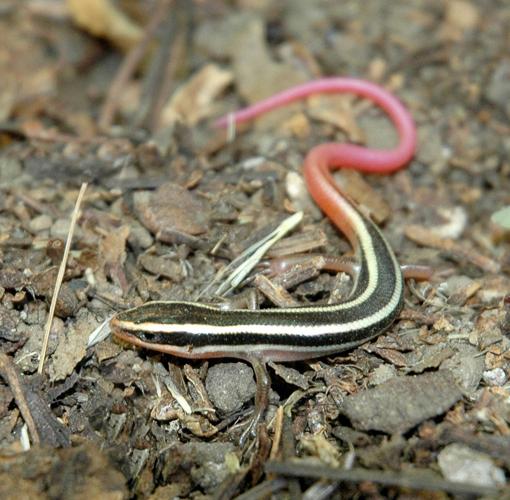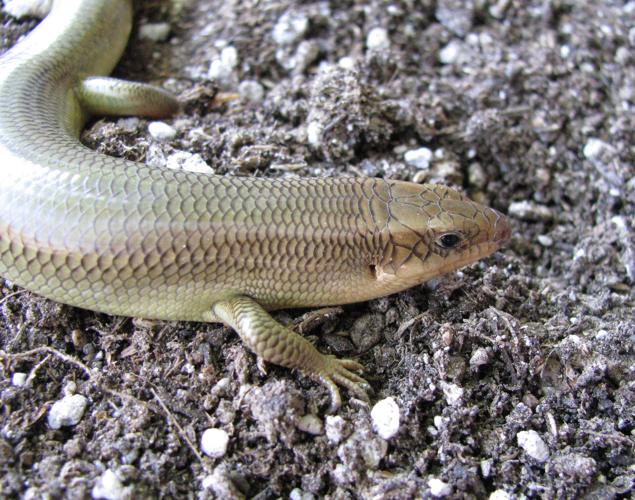Tehachapi area residents working in their yard occasionally uncover a smooth, shiny lizard with small legs and a pale olive coloration. The secretive lizards typically disappear as quickly as they were discovered, wriggling into the leaf litter and vanishing.
These distinctive creatures are known as skinks, and the species most often found in the Tehachapi Mountains is the Western Red-tailed Skin (Plestiodon gilberti rubricaudatus).
Skinks almost seem to be a cross between a lizard and a snake: they have a slick, polished feel and appearance like a snake, without a discernible neck, but they have the legs and body shape of a lizard.
Western Red-tailed Skinks are true lizards, of course, but their sleek lines enable them to move through their subsurface world with little friction. Skinks spend most of their lives neither above ground nor beneath it, but rather in the duff and accumulated plant material found lying on rich, composted soils.
As you would expect from small mulch-dwelling reptiles, skinks live on a diet of invertebrates like beetles, crickets, grasshoppers, termites, grubs, etc. They are active during daylight hours, but you seldom see them out in the open and they are most commonly encountered when you move an old log, piled lumber, weathered plywood or other objects under which they were hiding.
While adult Western Red-tailed skinks have a bland, greenish-tan coloration that enables them to blend in well with ground-level vegetation, juveniles sport alternating light and dark stripes that run the length of their body, ending with an eye-catching reddish or pink tail, which is the source of their common name.
Juvenile skinks have these brightly-colored tails to help save their lives: when faced with danger — and there are predators of many kinds that regard a young skink as a welcome snack — a skink can easily detach its tail, which will wiggle and twitch. While a predator's gaze is drawn to the pink tail, the skink itself can slip away to safety. The tail will then re-grow, but usually not as long as the original.
Most of the skinks found in California belong to one species — Gilbert's Skink (Plestiodon gilberti) which was first described by a herpetologist named John Van Denburgh in 1896 and named for noted ichthyologist Charles Henry Gilbert, one of the founding professors of Stanford University and once the world's leading authority on Pacific salmon.
There are four subspecies of Gilbert's Skink, including our Western Red-tailed Skink, and all of them appear similar. Juveniles of some subspecies have blue tails rather than red or pink. I've encountered striped juveniles with blue tails in the Tehachapi Mountains, which could be Western Red-tailed Skinks or an entirely different but also similar-looking species called Skilton's Skink (Plestiodon skiltonianus skiltonianus). California skink identification can be rather confusing. Some older field guides refer to all of them as Gilbert Skinks, and all older guide books use the genus Eumeces instead of Plestiodon (Pless-tee-oh-don), which is the current accepted term.
Skinks are curious-looking, unforgettable creatures who have been found in the fossil record dating back more than five million years. They are prone to bite if picked up, though with their small heads, their grip is mostly just a pinch. When they go to escape, whether from your hand or into the grass or leaf litter, they use a serpentine, side-to-side motion like a snake, since their bodies are strong and their legs are weak.
Skinks prefer to live in areas with some dampness, though they can live away from a water source and for months without rain as long as there are areas for them to hide where moisture persists.
Skinks are a welcome part of a healthy garden, and my brother and I have always considered it a lucky day when you get to encounter one of these shy lizards. You just have to admire them quickly, for they tend to vanish moments later.
Have a good week.
Jon Hammond has written for Tehachapi News for more than 30 years. Send email to tehachapimtnlover@gmail.com.







Commented
Sorry, there are no recent results for popular commented articles.